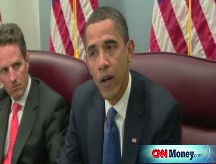Stimulus financing worries overblown?
Treasury report shows that foreign investors have continued to buy up U.S. Treasurys, easing some investor concerns that the government won't be able to finance stimulus.
NEW YORK (CNNMoney.com) -- China and Japan will stop lending to the United States! The U.S. government won't be able to finance its stimulus and bailout programs!
Those are the concerns that some analysts and investors have voiced over the past few months, as the government unveiled trillions of dollars in economic recovery and financial market liquidity programs and said they will ramp up their Treasury bond issuance to pay for it.
But those worries may be overblown.
"If you can't buy Treasurys, what can you buy?" said Michael Cheah, bond fund manager at AIG SunAmerica. "For the foreseeable future, to the extent that there is no alternative, big holders like Japan and China will continue to buy up U.S. Treasurys."
A report on foreign purchases of Treasurys Tuesday eased concerns that overseas investors would stop buying U.S. debt.
According to the Treasury International Capital (TIC) report released Tuesday, net foreign purchases of long-term Treasurys were $15 billion in December. The report relieved many investors' worries about the TIC data, which showed foreign investors had sold a net $25.8 billion of Treasurys in November.
China continued to lead all foreign nations, buying up an additional $14.3 billion of Treasurys in December. Japan, the second largest U.S. debt holder, bought up another $800 million of U.S. government bonds.
Though one month of data does not indicate a trend, analysts said they believe that the U.S. will continue to attract foreign investors, especially from Asia.
"The Chinese are locked into buying Treasurys," said Cheah. "It's not in their interest to do otherwise - it would kill their exporters and only make things worse."
Furthermore, droves of weak economic data from around the globe continue to hammer financial markets. With stocks floundering and commodity prices in flux, U.S. government debt has remained relatively attractive.
Treasury successfully completed a record $67 billion quarterly refunding last week, including the sale of 3-, 10- and 30-year bonds, attracting more than enough investors to fund the debt offerings.
As a result, investors' fears that the government will have difficulty making up for its escalating budget shortfall have eased somewhat.
The 10-year Treasury yield, which hit 3% for the first time since November on Feb. 6, fell below 2.7% on Tuesday, indicating an influx of bond investors over the past week and a half. Yields and prices move in opposite direction.
Still, with $787 billion it will owe for stimulus, $700 billion for the bank bailout and trillions more in liquidity programs, the Treasury expects to issue between $2.7 trillion - $4.2 trillion of debt over the next two years.
Not all are convinced that investors will continue to demand Treasurys when interest rates are again falling close to uncharted territory.
"The fear of trade is still on, and buyers can't find a better alternative elsewhere," said Kenneth Naehu, managing director at Bel Air Investment Advisors. "But the jury is still out whether the United States' ability to finance at low rates will continue to hold true, assuming the fear of trade tapers off."
Bond prices: U.S. bond markets were closed on Monday for the President's Day holiday.
On Tuesday, the price of the 10-year note rose 1-28/32 to 100-22/32 and its yield fell to 2.67%, down from 2.90% from late Friday. Bond prices and yields move in opposite directions.
The 30-year bond rose 3-9/32 to 100-2/32, and yielded 3.49%, down from 3.69%.
The 2-year note edged up 6/32 to 100-1/32 and its yield fell to 0.88% from 0.97%.
The yield on the 3-month note was unchanged at 0.30%. Demand for the shorter-term note is seen as a gauge for investor confidence.
Lending rates: Bank-to-bank lending rates were little changed. The 3-month Libor rate was 1.25% Tuesday, up from 1.24% Friday, according to data on Bloomberg.com. The overnight Libor rate, meanwhile, rose to 0.31% from 0.30%.
Libor, the London Interbank Offered Rate, is a daily average of rates that 16 different banks charge each other to lend money in London.
Two credit market gauges were showing a decrease in confidence in the lending markets. The "TED" spread widened to 0.95 percentage point from 0.94 percentage point on Friday. The bigger the TED spread, the less willing investors are to take risks.
Another market indicator, the Libor-OIS spread, increased to 0.98 percentage point from 0.97 percentage point the previous day. The wider the spread, the less cash is available for lending. ![]()




